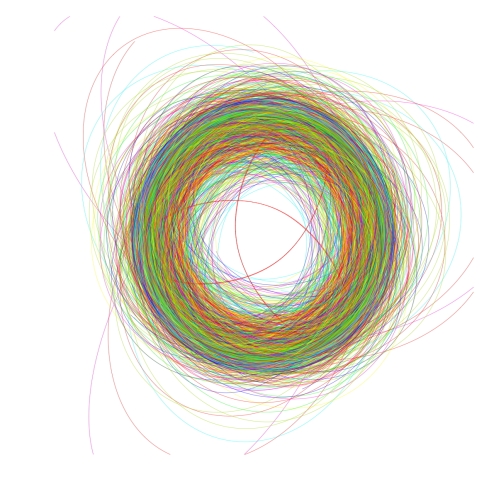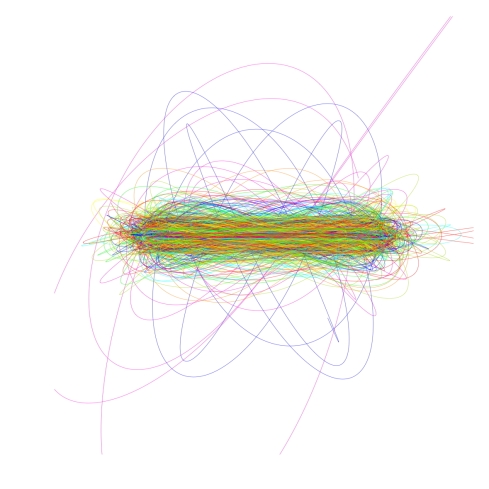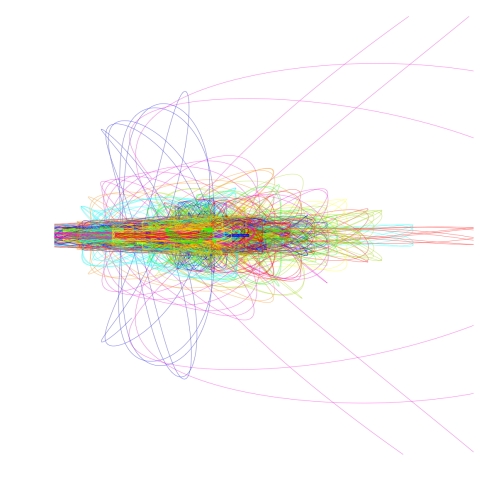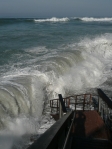A little astro art for today: as part of my analysis of stellar orbits of ultracool subdwarfs (presented at the 214th American Astronomical Society meeting in Pasadena, CA), I decided to try computing and visualizing the orbits of nearly 500 L-type dwarfs from the Sloan Digital Sky Survey (SDSS) based on kinematic data produced by Sarah Schmidt – you know, just for fun.
The orbits were generated by assuming that the gravitational potential of our Galaxy can be described by smooth, azimuthally symmetric functions (so-called “Plummer spheres“) that describe the thin disk, thick disk, halo and bulge populations of our Galaxy (see this link for good technical discussion of such models). I then use a simple numerical integrator (Runge-Kutta model) and the initial position and velocity vectors from Sarah’s work, to pre- and post-dict the orbits of these stars 500 million years into the past and future.
Each individual orbit is really a rough estimate of the star’s true path; uncertainties in the current distance and motion of the star, and the simplistic model used for the Galaxy, means that errors can creep up within a single Galactic orbit (about 200 million years for the Sun). However, a statistical picture of the entire population can be realized from this exercise. Stars are born from massive molecular clouds that typically have circular orbits in the plane of the Galactic disk. As stellar populations age, random encounters and secular disturbances can “puff” up their orbits to higher eccentricities and inclinations. This is visually apparent in an orbital plot.
This first figure shows the orbits as viewed from above. Note that the bulk of the stars fill an annulus, the outer edge of which is near the radius of the Sun’s Galactic orbit (our local neighborhood). Most of the stars in our area are coming from regions interior to this radius, rather than from the outer Galaxy, although a few L dwarfs do have pretty wide orbits (some off the projected area). At least one L dwarf gets within 1 kpc (3000 light years) of the center of the Galaxy.
This next image shows the same orbits, but now seen from the side along the edge of the Galactic plane. Again, we see that most of the orbits are bunched up into a band about 200 pc (600 light-years) in thickness – this is the “thin disk”. There is a loose skin of more inclined orbits that looks like a “thick” disk, and then a few L dwarfs that have crazy inclined orbits taking them thousands of light-years above or below the Galactic plane. A being standing on a planet around one of these stars 100 million years ago would have had a tremendous view of the Milky Way Galaxy!
This last image is my favorite, showing the same orbits but in a cylindrical projection: radial distance from the center of the Galaxy (at left) versus vertical distance below or above the plane. Families of orbits become quickly evident, occupying “boxes” in this diagram, the result of the symmetry of the gravitational potential used. The outer borders are defined by the total mechanical energy of the star, which is primarily set by the star’s local speed; the inner borders are defined by the angular momentum of the star. Thus, these two parameters – energy and angular momentum – are the two most important when working with symmetric potentials. These are the two quantities that best define planetary orbits around the Sun.
I found this to be a beautiful way of visualizing a fairly complex dataset, while illustrating the underlying orbital physics (as well as the assumptions made in the calculation). It’s also just beautiful, appearing as a dragonfly with meaty body and gossamer wings, a remarkably synergy between biological and astronomical systems.
This image was awarded 2nd prize in the 2011 Art in Science competition conducted by the UCSD Library (some of the other winners can be seen here). Who knew celestial mechanics can be both interesting and pleasing!







Recent Comments